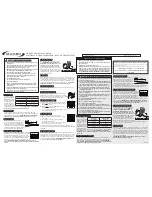
the supply and, if it exceeds approximately 120%
of maximum rated output, sends a turn-down signal
to the preregulator control circuit. Hence, the out-
put voltage of the supply is limited to a “safe” val-
ue despite any possible failure in the series regu-
lator feedback loop.
4-14 The turn-on control circuit is a long time
constant network which allows the supply to
achieve a gradual turn-on characteristic. The slow
turn-on feature protects the preregulator triac and
the series regulator from damage which might occur
when ac power is first applied to the unit. At turn-
on, the control circuit sends inhibiting voltages to
the preregulator control circuit and the s cries regu-
lator (via the error and driver amplifiers). A short
time after the unit is in operation, the inhibiting
voltages are removed and the circuit no longer ex-
ercises any control over the operation of the supply.
4-15 The reference supply provides stable refer-
ence voltages used by the constant voltage and
current comparators. Less critical operating volt-
ages are obtained from the bias supply.
4-16 DETAILED CIRCUIT ANALYSIS (See
4-17 PREREGULATOR CONTROL CIRCUIT
4-18 The preregulator minimizes changes in the
power dissipated by the series regulating transis -
tors due to output voltage or. input line voltage var-
iations. Preregulation is accomplished by means
of a phase control circuit utilizing triac A2CR1 as
the switching element.
4-19 In order to understand the operation of the
preregulator, it is important to understand the op-
eration of the triac. The triac is a hi-directional
device, that is, it can conduct current in either
direction. Hence, the device fires whenever it
receives a gating pulse regardless of the polarity
of the input a c that is applied to it. The triac is
fired once during each half-cycle (8.3 3 millisec-
onds) of the input ac (see Figure 4-3). Notice that
when the triac is fired at an early point during the
half-cycle, the ac level applied to the power trans-
former is relatively high. When the triac is fired
later during the half-cycle, the ac level is rela-
tively low.
4-20 Normally the ac input signal must be at a
certain minimum potential before the triac will con-
duct. However, A2R1 and A2C1 provide a holding
current that allows the triac to conduct at any time
during the ac input cycle. RFI choke A2L1A/A2L1B
(in series with the triac) slows down the turn-on of
the triac in order to minimize spikes at the output
of the supply. Components A2CR1, A2R1, A2L1A/
A2L1B, and A2C1 are all mounted inside a shielded
Triac Phase Control Over
AC Input Amplitude
box (assembly A2) to minimize radiated and reflect-
ed RFI. Further RFI suppression is provided by by-
pass capacitors C110 and C111.
4-21 The preregulator control circuit samples the
input line voltage, the output voltage, and the
voltage across the series regulator transistors. It
generates firing pulses, at the time required, to
fire the triac. This action maintains the ac input
voltage across the primary winding of T I at the de-
sired level.
4-22 The inputs to the control circuit are algebra-
ically summed across capacitor C70. All inputs
contribute to the time required to charge C70. The
input line voltage is rectified by CR81, CR82, CR83,
and CR84, attenuated by voltage divider R86 and
R83, and applied to the summing point at the col -
lector of Q71 (TP81) via capacitor C70. Capacitor
C73 is used for smoothing purposes.
4-23 Transistor Q71, connected in a common base
configuration, provides a charging current for the
summing capacitor varying in accordance with the
input signals applied to its emitter. Resistor R78,
connected between the negative output line and the
emitter of Q71, furnishes a signal which is propor-
tional to the output voltage. Resistors R75 and R76
sample the voltage across, and the current through,
the series regulator. Capacitor C72 and resistor
R82 stabilize the entire preregulator feedback loop.
Resistors R70 and R80 are the source of a constant
offset current which sustains a net negative charg-
T M 1 1 - 6 6 2 5 - 2 9 5 8 - 1 4 & P
Summary of Contents for 6260B
Page 70: ...Figure 7 4 Bottom Front Chassis Assembly Component Location Diagram 7 4 TM 11 6625 2958 14 P ...
Page 80: ...SECTION II MAINTENANCE ALLOCATION CHART TM 11 6625 2958 14 P D 3 ...
Page 83: ...Figure 7 11 Schematic Diagram Model 6269B ...
Page 88: ......
Page 89: ......
Page 91: ......
Page 92: ......
Page 93: ......
Page 94: ...THE METRIC SYSTEM AND EQUIVALENTS ...
Page 95: ...PIN 046413 000 ...
















































